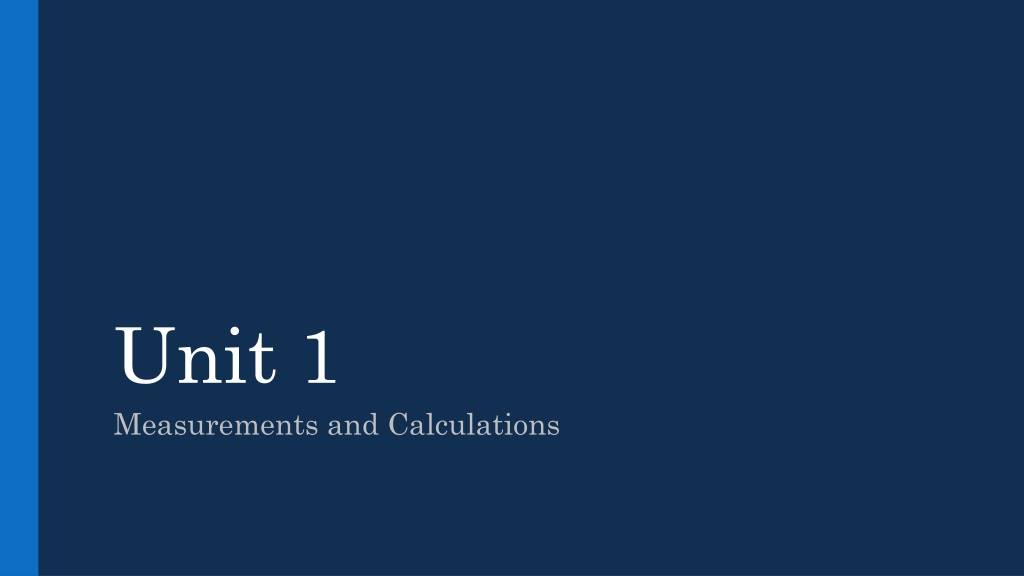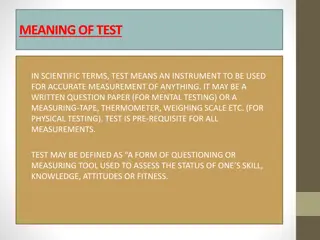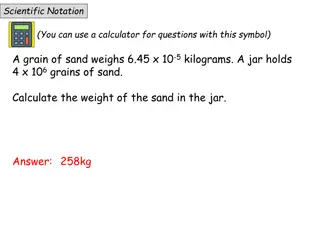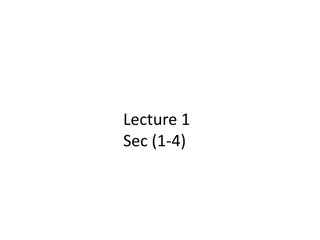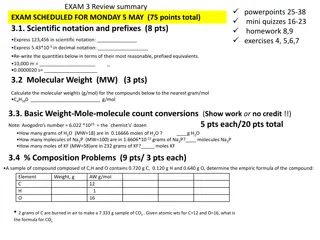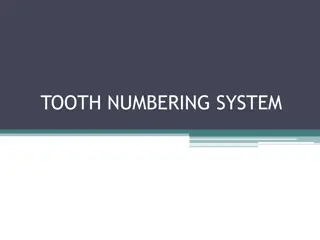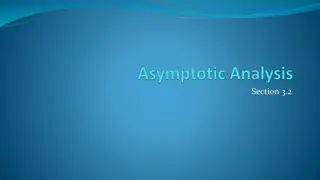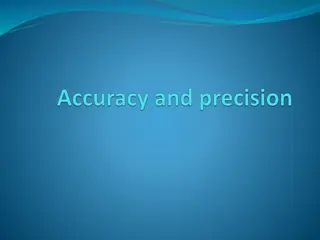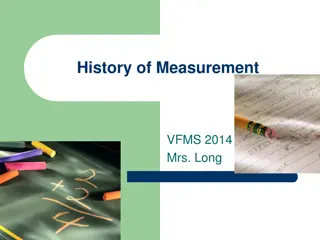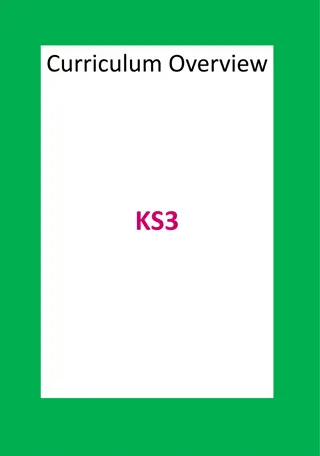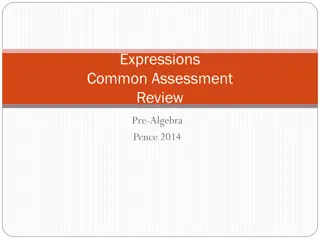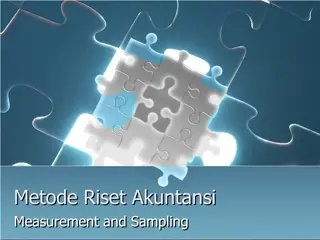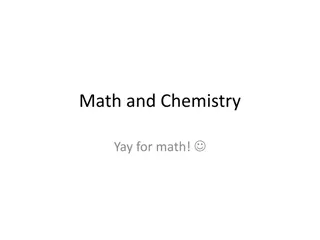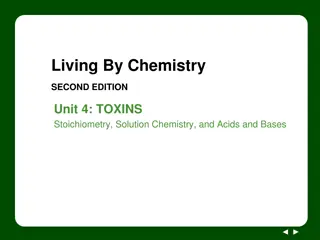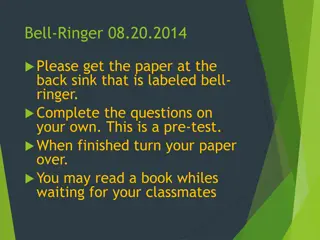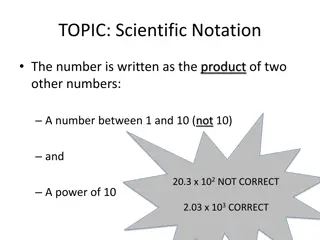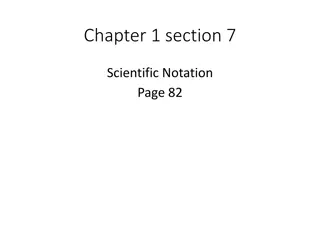Understanding Scientific Notation and SI Measurement Basics
Explore scientific notation as a method for expressing large and small numbers efficiently in mathematical calculations. Practice converting numbers into scientific notation and learn the rules for multiplication, division, addition, and subtraction in this format. Additionally, discover the benefits and basics of the SI measurement system for standardized units in scientific calculations.
Download Presentation

Please find below an Image/Link to download the presentation.
The content on the website is provided AS IS for your information and personal use only. It may not be sold, licensed, or shared on other websites without obtaining consent from the author. Download presentation by click this link. If you encounter any issues during the download, it is possible that the publisher has removed the file from their server.
E N D
Presentation Transcript
Unit 1 Measurements and Calculations
Scientific notation Scientific notation is a way to write very large or very small numbers Only one nonzero number can appear to the left of the decimal If you move the decimal to the left, the exponent is positive If you move the decimal to the right, the exponent is negative. Negative exponents represent the inverse of a number. Ex 10-3 = 1/1000 = 0.001 3
Scientific notation practice Write the following numbers in scientific notation 560,000 33,400 0.0004120 101.210 0.301 6,967,000 32.1 0.000000432 ____________________ ____________________ ____________________ ____________________ ____________________ ____________________ ____________________ ____________________ 4
Write the following numbers in scientific notation: 2,456,000,000 0.0000251 256.1 0.0217 Write the following numbers in scientific notation: 4.12 103 5.23 10-7 9.01 105
Multiplying and Dividing When multiplying numbers in scientific notation, multiply the numbers and add the exponents. (2.15 1015)(5.134 1034) = ___________________ (1.234 10-4)(5.134 102) = ___________________ Dividing Divide numbers first, then subtract exponents 3.12 109 / 4.355 103= ___________________ 9.10 10-7 / 5.014 102= ___________________
Addition and Subtraction To add or subtract, move decimal places so that exponents are the same and then carry out the operation. 7.142 105+ 4.12 103= ___________________ 1.024 10-2 3.12 10-3= ___________________
SI measurement A measurement must include a value and a unit. Example: 54.3 grams (g) Benefits: Everything goes by 10 s. Standard naming Calculations and conversions are easier to perform. 8
Significant Figures (Sig Figs) What are they? The minimum number of digits required to report a value without loss of accuracy. Why are they useful? Tells us the accuracy of the data. Also gives insight into the instrumentation used to take the measurement. For example: If a scientist reports the mass of a compound, which is more accurate? 100 g 100.3 g 100.3574 g?
All known plus one estimated when reading measurements! 12
Significant Figures (Sig Figs) Rule Example 1.) Zeros appearing between non-zero digits are significant. a. 40.7 has three sig figs. b. 56,007 has five sig figs. 2.) Zeros appearing in front of all nonzero digits are not significant. a. 0.023154 has five sig figs. b. 0.00002 has one sig fig. 3.) Zeros at the end of a number and to the right of the decimal place are significant. 4.) Zeros used as placeholders are not significant. a. 85.00 has four sig figs a. 2000 has one sig fig b. 34,000 has two sig figs 5.) A decimal point placed after zeros indicates that they are significant. a. 2000. has four sig figs b. 35,000. has five sig figs
Significant figures examples How many significant figures are in each of the following measurements? 28.6 g _________ 3440. cm _________ 910 m _________ 0.04604 L _________ 0.0067000 kg _________ Suppose the value seven thousand centimeters is reported, how would you express the number to . . . 1 significant figures _______________ 4 significant figures _______________ 6 significant figures _______________ 14
Significant figures cntd. Addition and subtraction the answer must have the same number of digits to the right of the decimal as the number having the fewest number of digits to the right of the decimal Look to the right of the decimal Fewest number of decimal places wins. Multiplication and division the answer must have the same number of digits as the number having the fewest number of digits Look at the entire number Least number of digits wins 15
Examples Carry out the following calculations. Express each answer to the correct number of significant figures. 5.44 m 2.6103 m = 2.4 mL x 15.82 mL = 2.099 g + 0.05681 g = 87.3 cm 1.655 cm = Calculate the area of a rectangle that measures 1.34 mm by 0.7488 mm. 16
Prefixes Prefixes are used to identify quantities that are much higher or much lower than the base units 18
Converting Start with the GIVEN Set your conversion line up Write your units, so the units will cancel Put a 1 with the largest unit Put the equivalent conversion factor with the smaller unit ALWAYS stop at the base unit!!!!!! Multiply across the top and multiply the bottom
Practice - GENERAL Complete the following conversions: 10.5 g = ______________ kg 1.57 mm = ______________ m 1.2 L = ______________dL 78.3 cJ = _______________ J 323 J = _______________ mJ 20
Practice - HONORS Complete the following conversions: 10.5 g = ______________ pg 1.57 km = ______________ m 1.2 L = ______________ mL 971.3 g = _______________ g 78.3 cJ = _______________ kJ 323 mJ = _______________ nJ 21
White board practice - GENERAL Complete the following conversions: 890 L = ______________ mL 5.234 km = _______________ m 48.9 g = _______________ kg 0.0658 g = _______________ cg
White board practice - HONORS Complete the following conversions: 890 L = ______________ mL 5.234 km = _______________ cm 48.9 hg = _______________ kg 0.0658 kg = _______________ mg
BELL RINGER - HONORS Complete the following conversions, put your answer in correct scientific notation with correct significant figures: ______________ mL 556.2 L = 83.2 ng = ___________________ g _______________ nm _______________ kg 87.00 km = 0.0056 g = 2.05 J = _______________ pJ 5.234 km = _______________ cm _______________ mg 0.0658 kg =
BELL RINGER - GENERAL Complete the following conversions, put your answer in correct scientific notation with correct significant figures: ______________ mL 556.2 L = 83.2 cg = ___________________ g 87.00 km = _______________ m 0.0056 g = _______________ kg 2.05 J = _______________ dJ
Dimensional Analysis What is it? A way to use units to solve mathematical problems involving measurements. Quantity sought = quantity given conversion factor How many quarters are in 12 dollars?
Dimensional Analysis Problems 1.) How many centimeters are in 2.5 miles (1 mile = 1.61 km)? 2.) How many seconds are in 3.23 years? 3.) How many nickels are in 56.32 dollars? 27
More practice conversions 1 min = 60 sec 1 ton = 2000 lbs 1 hr = 60 min 7 days = 1 week 1 kg = 2.2 lbs 1 gal = 3.79 L 24 hrs = 1 day 264.2 gal = 1 cubic meter 1 kg = 1000 g 1 lb = 16 oz 1 mi = 5,280 ft 20 drops = 1 mL Convert 5.93 cm3to m3 52 weeks = 1 yr 2.54 cm = 1 in 365 days = 1 yr 1 L = 1000 mL 1 yd = 36 inches 1 cc is 1 cm3 0.621 mi = 1.00 km 1 mL = 1 cm3 How fast is 50 mph in km/sec? Traveling at 65 miles/hour, how many feet can you travel in 22 minutes?
White boarding Practice - Honors 1 min = 60 sec 1 kg = 2.2 lbs 1 kg = 1000 g 52 weeks = 1 yr 1 ton = 2000 lbs 1 gal = 3.79 L 1 lb = 16 oz 2.54 cm = 1 in 1 cc is 1 cm3 1 hr = 60 min 24 hrs = 1 day 1 mi = 5,280 ft 365 days = 1 yr 0.621 mi = 1.00 km 1 yd = 36 inches 7 days = 1 week 264.2 gal = 1 cubic meter 20 drops = 1 mL 1 L = 1000 mL 1 mL = 1 cm3 1. 1 mL of ink can print 50 pages of text. If you had 100 gallons of ink then how many pages could you print? 2. The moon is 384,403 km from the earth. Estimate how many quarters laid end to end it would take to reach the moon if a quarter has a diameter of 2.3 cm. 3. The distance from a Port Huron to the Indiana State line is approximately 271 miles (via I-94). Express this distance in kilometers.
White boarding Practice - GENERAL 1 min = 60 sec 1 kg = 2.2 lbs 1 kg = 1000 g 52 weeks = 1 yr 1 ton = 2000 lbs 1 gal = 3.79 L 1 lb = 16 oz 2.54 cm = 1 in 1 cc is 1 cm3 1 hr = 60 min 24 hrs = 1 day 1 mi = 5,280 ft 365 days = 1 yr 0.621 mi = 1.00 km 1 yd = 36 inches 7 days = 1 week 264.2 gal = 1 cubic meter 20 drops = 1 mL 1 L = 1000 mL 1 mL = 1 cm3 1. If a faucet is dripping 12 drops per second. How many mL would this make in an hour? 2. If a car is traveling at 4.5 meters every second, how many feet will it travel in 45 minutes? 3. The distance from a Port Huron to the Indiana State line is approximately 271 miles (via I-94). Express this distance in kilometers.
Volume (V) Two ways to measure the volume of solids: 1.) Regularly-shaped Measure length, width, and height then multiply. 2.) Irregularly-shaped Must measure using displacement of water. Units of measurement for volume: m3, cm3, mL 1 mL = 1 cm3
Volume problems 50 mL of water was added to a 100 mL beaker. A rock was added and the water level rose to 55.5 mL. What is the volume of the rock? Calculate the volume of a dresser having a length of 1.2 m, a height of 1.98 m, and a depth of 0.60 m. 32
Density problems 1. What is the density of a block of marble that occupies 310. cm3and has a mass of 853 g? 1. Diamond has a density of 3.26 g/cm3. What is the mass of a diamond that has a volume of 0.351 cm3? 1. What is the volume of a sample of liquid mercury that has a mass of 76.2 g, given that the density of mercury is 13.6 g/mL? 34
Density problems cntd. 4. What is the density of an 84.7 g sample of an unknown substance if the sample occupies 49.6 cm3? 4. What volume would be occupied by 7.75 g of this same substance? 35
Temperature Temperature the quantity of the energy of motion of the particles that make it up Three scales C, F, K (no degrees sign for Kelvin) K = C + 273.15 0 K = Absolute Zero 36
Accuracy and Precision Accuracy how close a measurement is to the actual value. Precision how close together a group of measurements are.
Representing data Direct Relationship as one value increases, the other value increases Indirect relationship or inverse relationship as one value increases, the other value decreases 40
Direct Relationship Indirect Relationship 41
